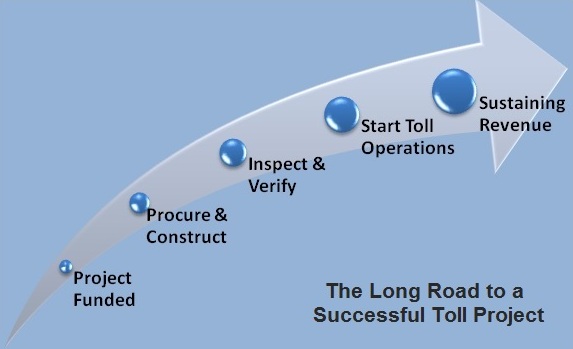A number of metrics can be used to measure the success of a toll project. However, the most fundamental of all is the development of a sustained revenue stream that recovers the costs of the project. A number of toll projects have been criticized recently for failing to meet this minimum requirement:
“Government to Rescue Empty Toll Roads ”
“Tollway Could Default Without Refinance Plan”
“Moody’s Downgrades Toll Road Company”
“Toll Road Agency Generates $1.7B in Red Ink”, and
“Bidders Sought for Bankrupt Toll Road”.
In these situations the traffic and revenue forecasting process typically receives the brunt of the blame, but estimating revenue is just one of many functions that needs to be conducted properly for the project to be a winner. Once funding has been established the road to a sustained revenue stream is long and fraught with a myriad of complex tasks that must all be appropriately managed for the toll project to be a success. To criticize the traffic and revenue estimates when a project is struggling or fails financially may be diverting attention from other, more serious problems in the project development and implementation process.
Factors That Can Impact Revenue Beyond Control of the Project Development Team
A number of events beyond control of the project development team can arise that impact the project’s revenue stream, including:
• major economic downturns
• significant increases in the costs of vehicular transport (e.g. fuel)
• policy and regulatory changes
• errors in the budgetary planning process, and
• variations in the public’s anticipated acceptance of the project.
Ideally, these risks have been identified, their potential impacts on revenue considered in the revenue studies and a contingency fund has been established to mitigate their impact on the project’s viability.
Other Factors That Can Impact the Project’s Feasibility
Marketing the project and managing costs during project development and operations are also critical to success. Traffic and revenue forecasts inherently assume that those marketing the facility and managing construction and operations will make the most appropriate decisions to sustain the project. Unfortunately, this is not always the case.
An independent review of the project design, procurement, construction and operations phases, a role typically referred to as that of the “owner’s representative”, includes:
• verification of the operations plan (including marketing)
• value engineering of all design efforts
• confirmation that the procurement process is competitive and appropriate
for each acquisition
• corroboration of work progress (schedule, content and changes)
• site inspections
• systems testing and verification, and
• systems and operations audits once the facility is open to revenue service.
Retaining experienced professionals to be the “owner’s representative” during project development and implementation can help avoid mistakes and manage the challenges that inevitably arise and have a significant impact on a project’s viability.
Conclusion
Over the last several years independent verifications of revenue estimates have been routinely sought. An independent review and evaluation of project design, procurement, construction and operations functions is also warranted.
© 2014 The eTrans Group, Inc.
